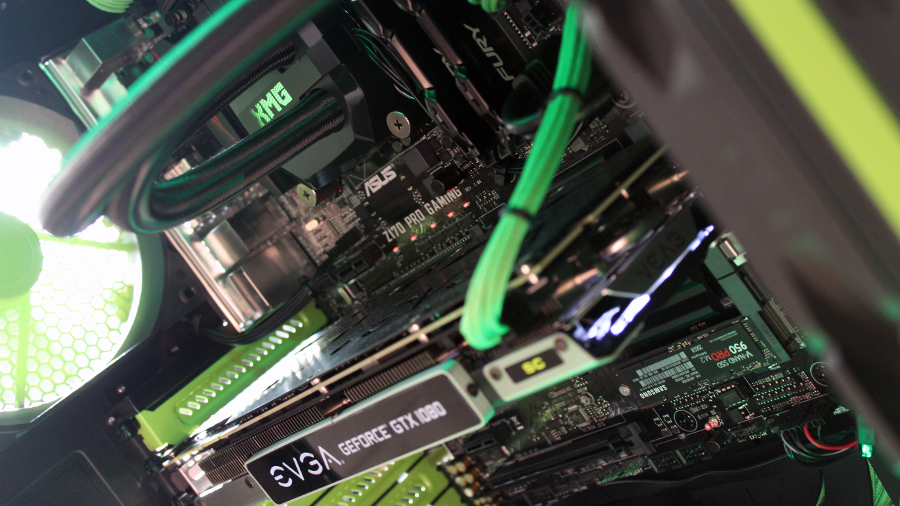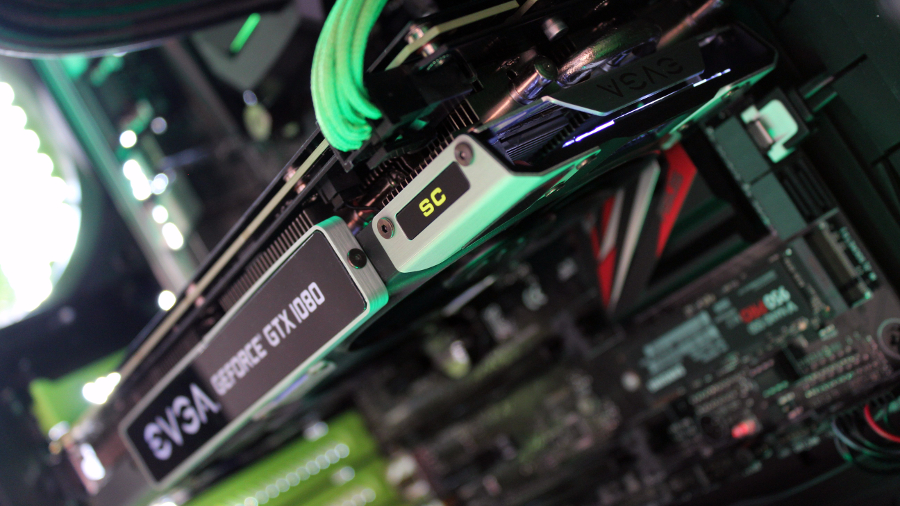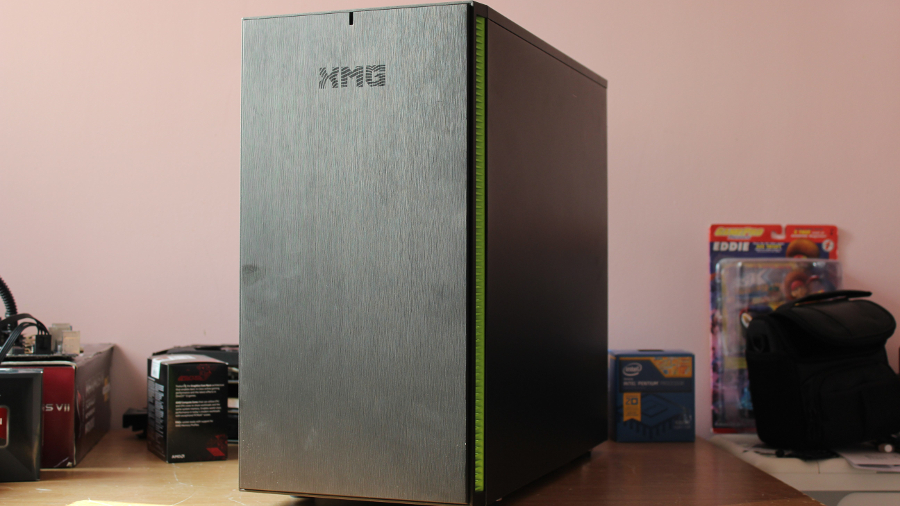TechRadar Verdict
The overclocked core components ensure that this PC can handle 4K and VR gaming, and the specification is built solidly inside a sturdy, good-looking case. It's a little expensive, but this machine justifies its price by excelling in every key department.
Pros
- +
Superb gaming speed
- +
Impressive overclocked CPU
- +
Consistent, smart build quality
Cons
- -
Pricier than rivals
- -
Can't see attractive internals
- -
Slightly slow memory
Why you can trust TechRadar
German firm XMG is better known for its laptops, but the Sector2 marks a fresh foray into desktop PCs. With competitive gaming on the rise, it makes sense – but is this machine perfect for League of Legends and DOTA?
Design
There’s no mistaking this machine’s brand. The XMG logo is on the smart front panel, and that’s not all – the XMG lettering is found on the internal fans, and on the Corsair Hydro H115i cooler’s CPU waterblock.

The branding isn’t just about those three letters – it’s colours, too. The Fractal Design Define S enclosure’s smart side panels are black, and every bit of detail is finished in green. On the outside, that means the logos on the USB and audio jacks are green, alongside the air intake slats down the front.
The two-tone colour scheme is prevalent on the inside. The power cables are individually braided in green, and the radiator has coloured insets. The case fans have green blades, and the rear of the motherboard tray and PCI blankers are finished in the same colour.

There are even LED strips that illuminate the interior in green. The machine looks superb – coherent and smart – but there’s no window, which means the design is rarely seen. A windowed option is available, but it costs extra.
That’s a minor issue, and there’s plenty to like elsewhere. Those side panels are supremely strong, and they’re lined with sound-absorbing material. The build is tidy: XMG has done a stellar job of keeping cables neat, which means this rig’s free memory sockets, SATA ports and PCI slots are accessible. There’s room for two more SSDs and a couple of hard disks around the back, too.

The XMG Sector2 is smarter and more subtle than both rivals. The StormForce Tornado arrived with a white case with ostentatious angles that made it look like a Storm Trooper, and the Alienware Aurora R5 stunned with its customisable lighting and smaller footprint.
Sign up for breaking news, reviews, opinion, top tech deals, and more.

Spec sheet
Here are the specs of the XMG Sector2 which was provided to TechRadar:
- CPU: 4.4GHz Intel Core i5-6700K processor (Quad-core, 8MB cache)
- Graphics: EVGA Nvidia GeForce GTX 1080 (8GB GDDR5X RAM)
- RAM: 16GB DDR4 (2,400MHz)
- Storage: 256GB Samsung 950 Pro SSD, 1TB 7,200rpm hard disk
- Motherboard: Asus Z170 Pro Gaming
- Case: Fractal Design Define S XMG Edition
- Connectivity: Gigabit Ethernet
- Operating system: Windows 10 64-bit
- Power supply: 650W Corsair RM650x
- Ports: Front: 2 x USB 3, 2 x audio; Rear: 4 x USB 3, 2 x USB 2, 1 x USB 3.1 Type-A, 1 x USB 3.1 Type-C, 1 x PS/2, 5 x audio
- Size: 9.2in x 20.9in x 18.3in (W x D x H; 233 x 533 x 465mm)
- Warranty: 3yr collect and return
XMG has kitted this machine out with enticing core components. The Nvidia GeForce GTX 1080 is the market’s most exciting graphics card thanks to the Pascal architecture, and XMG has gone one better – this EVGA-made version raises the speed from 1,607MHz to 1,708MHz.
The Core i7-6700K has four Hyper-Threaded cores to swat aside tough multi-tasking, and this PC arrives with the 4GHz speed overclocked to 4.4GHz.
There’s 16GB of DDR4 memory, although it’s clocked to 2,400MHz – a little slow. Storage comes from the superb Samsung 950 Pro SSD, and there’s a 1TB hard disk.

The Asus Z170 Pro Gaming is an impressive PCB. It’s got good-looking heatsinks and plenty of free slots and sockets, and it has game-friendly Ethernet and audio circuitry. Money has been saved by not including enthusiast features like on-board buttons and displays, but that’s fine – they’re of limited use in a pre-built rig.
This core specification is excellent, and XMG offers ample customisation. Money can be saved with the cheaper GTX 1060 and GTX 1070, and a second GTX 1080 can be added for incredible gaming horsepower. The CPU overclock can be removed to save more cash, and there are dozens of options for memory and storage. Power supplies can be switched, operating systems can be changed, and the generous warranty can be upgraded to a premium deal.
The Sector2 has a similar specification to the Alienware – the core components are the same, but there are no overclocks – but XMG’s machine is pricier than the Aurora, which costs $2,529 (about £1,899, AU$3,390) for that configuration. XMG’s machine is a step up from the StormForce Tornado, though, which made do with a Core i5 processor and a GTX 1070 GPU – and no SSD – for $1,180 (£899, AUS$1,540).

Benchmarks
- 3DMark: Cloud Gate: 34,291; Sky Diver: 38,068; Fire Strike: 17,818
- Cinebench R15: CPU: 965cb; Graphics: 170.49fps
- PCMark 8 (Home Test): 5,376
- GeekBench: 4,723 (single-core); 18,749 (multi-core)
- Metro: Last Light: 147.11fps (1080p, Ultra); 57.49fps (4K, Ultra)
- Middle Earth: Shadow of Mordor: 164.39fps (1080p, Ultra); 65.94fps (4K, Ultra)
- Bioshock Infinite: 187.68fps (1080p, Ultra); 70.5ps (4K, Ultra)
- GTA V: 70fps (1080p, Ultra); 22.9fps (4K, Ultra); 51.9fps (4K, Ultra, no AA)
There’s no doubt about the XMG’s gaming credentials. Its 3D Mark Fire Strike score of 17,818 is stellar: more than 2,000 points ahead of the Alienware, and about level with the StormForce Tornado.
The XMG was ten frames ahead of the StormForce in the Cinebench gaming test, and even further ahead of the Alienware Aurora R5 – that system could only manage 132.5fps.

This theoretical power translated to real-world tests. Its GTA V 1080p average of 70fps is easily playable, and matches the StormForce system. The Alienware was eight frames quicker, but at this level that won’t make a noticeable difference.
In every other 1080p test the XMG blasted beyond 100fps – no surprise, as the GTX 1080 is designed for 4K gaming. The XMG excelled here, too: it averaged 57fps in Metro: Last Light, and hit a stonking 71fps in Bioshock Infinite.
The XMG stumbled to 23fps in GTA V run at 4K, but turning off anti-aliasing made a huge difference – that average jumped to a smooth 52fps.

This PC will play any game at 4K, and it’s bolstered by solid CPU performance. The XMG’s PC Mark 8 Home result of 5,376 points is far quicker than both rivals – no surprise considering the CPU overclock. The system boots quickly, too, thanks to SSD read and write speeds of 1,363MB/s and 1,243MBs – twice as quick as the best SATA SSDs.
This machine remained quiet, but we had concerns over heat due to the noise-dampening material and lack of proper air intake fans. Thankfully, the XMG coped: its CPU and GPU peak temperatures of 88°C and 80°C are high, but not dangerous.
Final verdict
XMG’s machine is more expensive than its key rival from Alienware, but it justifies the cost in several important departments. Its key component overclocks give it better performance in a host of benchmarks, and its traditional tower layout means it’s more versatile when it comes to upgrading.
It’s a tad expensive given the components included, but there’s no denying the quality throughout. If you’re after a future-proofed and well-built traditional tower, you could do a lot worse than this.
Mike has worked as a technology journalist for more than a decade and has written for most of the UK’s big technology titles alongside numerous global outlets. He loves PCs, laptops and any new hardware, and covers everything from the latest business trends to high-end gaming gear.
